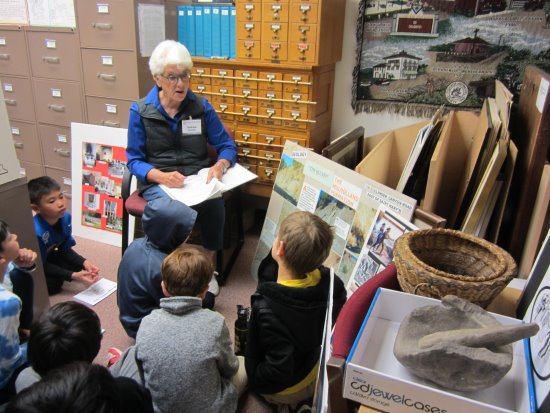
| ||||||
The first group to drop by was Rheem teacher Jessica Stafford's class of approximately 24 students. Two more third-grade classes were scheduled that day, making a total of about 75 students coming from Rheem.
The students were split into three groups which rotated through 18-20 minute sessions of major time periods in Moraga's history. Historical Society President Susan Sperry covered the prehistoric period of Moraga's past when the town, as we know it, was submerged under the Pacific Ocean millions of years ago, and telling the students that when the water slowly receded, eventually dinosaurs roamed the area. Sperry had photos that showed mastodon footprint fossils.
Sperry also discussed the Saklan tribe: "They covered their bodies in mud in the winter to keep warm. Some people pay a lot of money to do that today." While that bit of trivia seemed to go over the third-graders' heads, the moms in the room found it funny. The students were also shown an authentic, centuries-old mortar and pestle which the tribes used to ground acorns.
The ranchos of the area, specifically the one owned by Jose Joaquin Moraga and his cousin Juan Bernal, were briefly touched upon as the perfect segue for this particular group of students to move into the artifacts room for their next lesson about life on a Moraga ranch.
Historical Society First Vice President Colleen Lund spoke about what life was like on a mid-19th century rancho or farm. She tried to trick the students by mentioning electricity and bathrooms, but they were quick to correct her. The kids named possible breakfast items such as berries, eggs, water from wells and milk from cows. Deciding how they would've gotten to school ranged from walking, wagons or horseback, with one student shouting out, "By bus!"
Topics included squatters on the land and California's Gold Rush, which brought with it the "49ers" moniker. One student suggested that "their clothes were red and gold," a clear reference to San Francisco's professional football team.
Lund had many artifacts on display to show the class such as old irons and kerosene lamps. She opened drawers to reveal tribal artifacts of arrowheads and jewelry before concluding her segment of Moraga's history.
The third and final significant time period in the town's history was "conducted" by Moraga Historical Society Member Sam Sperry, while dressed as a train conductor. Standing before a diorama (made by Les Krames) of the old Saint Mary's College Station complete with a freight engine alongside it, Sperry regaled the students with facts pertaining to the area's Sacramento Northern Railway (1913-1957).
After handing out copies of the railway's route map, which noted landmarks that the students could relate to, he explained that the all-electric train system carried both passenger and freight cars. Beginning in Oakland, the train traversed through a 3,000-foot tunnel under Skyline Blvd. (Shepard Pass Tunnel), eventually coming through Canyon, Moraga, Lafayette, Walnut Creek, Concord and some other stops before going through Sacramento to its final destination of Chico.
Sam Sperry explained that the passengers consisted of commuters, SMC college students and professors, high school students (going to school in Concord before Campolindo and Miramonte were built), and picnickers coming into Canyon.? The freight cars carried redwood lumber, walnuts and pears, cattle, grain, as well as military equipment and ammunition during WWII.
Passenger service ended in 1941 due to the convenience of cars, the opening of the Bay Bridge, an improved Caldecott Tunnel, and more paved roads. Freight service ended in 1957 because of lumber depletion.? Walnut and?pear trees, along with many ranches, were replaced by subdivisions.
As if that wasn't enough history for one hour, all classes continued their lesson by also visiting the Joaquin Moraga Adobe located in Orinda, later in the day.
Reach the reporter at:
